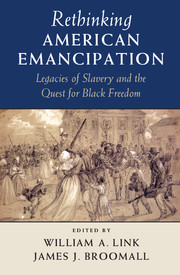Book contents
- Frontmatter
- Contents
- List of figures
- Notes on the Editors and Contributors
- Acknowledgments
- Introduction
- I CLAIMING EMANCIPATION
- 1 Bodies in Motion and the Making of Emancipation
- 2 Force, Freedom, and the Making of Emancipation
- 3 Military Interference in Elections as an Influence on Abolition
- II CONTESTING EMANCIPATION
- III REMEMBERING EMANCIPATION
- Index
2 - Force, Freedom, and the Making of Emancipation
from I - CLAIMING EMANCIPATION
Published online by Cambridge University Press: 05 November 2015
- Frontmatter
- Contents
- List of figures
- Notes on the Editors and Contributors
- Acknowledgments
- Introduction
- I CLAIMING EMANCIPATION
- 1 Bodies in Motion and the Making of Emancipation
- 2 Force, Freedom, and the Making of Emancipation
- 3 Military Interference in Elections as an Influence on Abolition
- II CONTESTING EMANCIPATION
- III REMEMBERING EMANCIPATION
- Index
Summary
Historians have long struggled to describe the kind of freedom slaves were emancipated into. Because freedom is so famously difficult to define, and because purely legalistic definitions of freedom as “not slavery” don't leave much analytic room to maneuver, scholars often turn to metaphorical language. While the particular meaning of emancipation in the 1860s South took many different forms, one set of languages that emerged in the 1840s and 1850s provided a particularly useful, but also at times limiting, way of thinking about freedom as a space to move into. This essay investigates the development of spatial and other metaphors of freedom in antebellum America and their limits in explaining the particular freedom that emerged at the end of the Civil War.
The primary obstacle to understanding freedom lies in its notoriously slippery definitions. Historians of U.S. slavery often follow the language of escaped slaves themselves by stating not what freedom was, but where it was. Henry Bibb, one of the sharpest autobiographers of the antebellum era, captured the power and elusiveness of slavery in evocative passages where he stood on the bluffs over the Ohio River, “looking over on a free State, as far north as my eyes could see, I have eagerly gazed upon the blue sky of a free North.” For Bibb, the Ohio River's marking line between slavery and freedom gestured toward the even brighter division between Canada, “a land of liberty,” and the United States. “Oh! Canada, sweet land of rest – Oh! When shall I get there? Oh, that I had the wings of a dove, that I might soar away to where there is no slavery.” Thinking about freedom as a place made particular sense to Bibb, who eventually lived in the North, and farther north in Canada. In the regionally fragmented antebellum United States, the notion of a sweet land of liberty (a phrase immortalized in a song written in 1831) seemed unavoidable. As the movement for gradual emancipation ground to a halt at the Mason-Dixon line, Americans of all colors confronted an increasingly divided country, where not just laws but broader ways of conceiving slavery, race, and freedom seemed to be geographically determined.
- Type
- Chapter
- Information
- Rethinking American EmancipationLegacies of Slavery and the Quest for Black Freedom, pp. 42 - 68Publisher: Cambridge University PressPrint publication year: 2015

